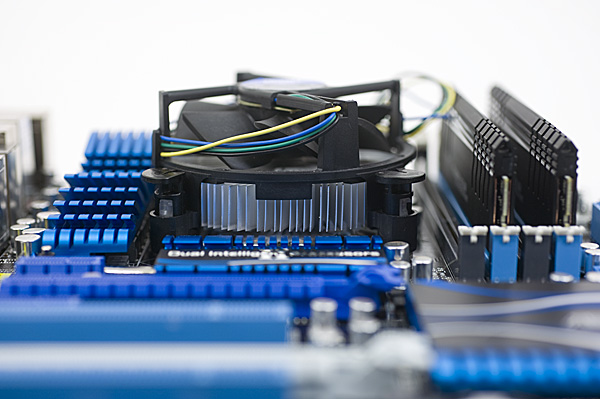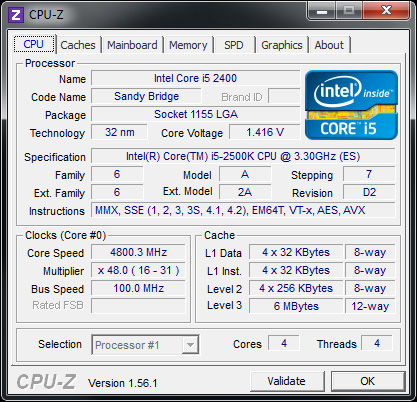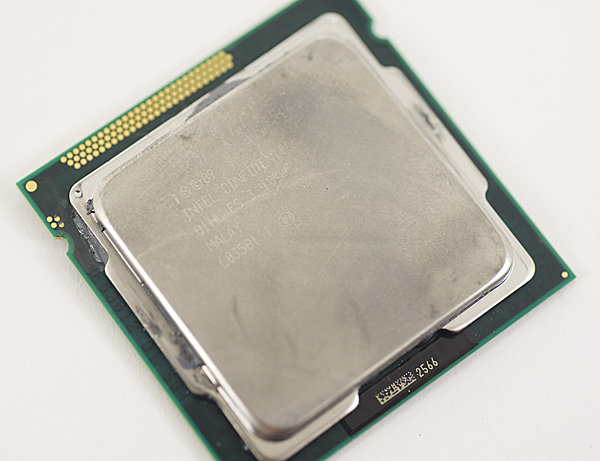The Sandy Bridge Review: Intel Core i7-2600K, i5-2500K and Core i3-2100 Tested
by Anand Lal Shimpi on January 3, 2011 12:01 AM ESTOverclocking, the K-Series and What You’ll Want to Buy
If you haven’t noticed, the computing world is becoming more integrated. We review highly integrated SoCs in our smartphone coverage, and even on the desktop we’re seeing movement towards beefy SoCs. AMD pioneered the integrated memory controller on desktop PCs, Intel followed suit and with Lynnfield brought a PCIe controller on-die as well. Sandy Bridge takes the next logical step and brings a GPU on-die, a move matched by AMD with Brazos and Llano this year.
In the spirit of integration, Intel made one more change this round: the 6-series chipsets integrate the clock generator. What once was a component on the motherboard, the PLL is now on the 6-series chipset die. The integrated PLL feeds a source clock to everything from the SATA and PCIe controllers to the SNB CPU itself. With many components driven off of this one clock, Intel has locked it down pretty tight.
With Nehalem and Westmere, to overclock you simply adjusted the BCLK from 133MHz to whatever speed you wanted and sometimes toyed with multipliers to arrive at a happy end result. With Sandy Bridge, the BCLK generated on the 6-series PCH is at 100MHz by default and honestly won’t go much higher than that.
While I’ve heard reports of getting as high as 115MHz, I’d view 103—105MHz as the upper limit for what you’re going to get out of BCLK overclocking. In other words: next to nothing. A 105MHz BCLK overclock on a Core i7-2600 will take you from a stock speed of 3.4GHz to a whopping 3.57GHz. The form of overclocking we’ve been using for the past decade is effectively dead on Sandy Bridge.
Years ago, before the Pentium II, we didn’t rely on BCLK (or back then it was just FSB or bus overclocking) to overclock. Back then, if we wanted a faster CPU we’d just increase the clock multiplier. Intel has dabbled in offering multiplier unlocked parts for overclockers, we saw this last year with the Core i7 875K for example. With Sandy Bridge, those unlocked parts are going to be a lot more important to overclockers.
It works like this. If you have a part that does not support Turbo (e.g. Core i3-2100 series), then your CPU is completely clock locked. You can’t overclock it at all, have fun at your stock frequency. This is good news for AMD as it makes AMD even more attractive at those price points.
If you have a part that does support turbo (e.g. Core i5-2400), then you have what’s called a “limited unlocked” core—in other words you can overclock a little bit. These parts are limited to an overclock of 4 processor bins above and beyond the highest turbo frequency. Confused yet? This chart may help:
In this case we’re looking at a Core i5-2500, which runs at 3.3GHz by default. When a single core is active, the chip can turbo up to 3.7GHz. If you want, you can change that turbo state to go as high as 4.1GHz (if your CPU and cooling can keep up).
Overclocking these limited unlocked chips relies entirely on turbo however. In the case above, the fastest your chip will run is 4.1GHz but with only one core active. If you have four cores active the fastest your chip can run is 3.8GHz. While Intel didn’t sample any limited unlocked parts, from what I’ve heard you shouldn’t have any problems hitting these multiplier limits.
There’s a third class of part: a fully unlocked K-series chip. At launch there are only two of these processors: the Core i5-2500K and the Core i7-2600K. Anything with a K at the end of it means you get all multipliers from 16x all the way up to 57x at your disposal. It’s effectively fully unlocked.

These chips overclock very well. Both my Core i5-2500K and Core i7-2600K hit ~4.4GHz, fully stable, using the stock low-profile cooler.

This is all you need for 4.4GHz
With a bit more effort and a better cooler, you can get anywhere in the 4.6-5.0GHz range:

It's a bit too early to tell how solid these near-5GHz overclocks will be, but I'm confident in the sub-4.5GHz overclocks we were able to sustain.
You do pay a price premium for these K-series SKUs. The 2500K will cost you another $11 over a stock 2500 and the 2600K costs an extra $23. In the case of the 2500K, that’s a small enough premium that it’s honestly worth it. You pay $11 extra for a chip that is very conservatively clocked and just begging for you to overclock it. Even the 2600K’s premium isn’t bad at all.
| Model Number | Standard SKU | K-Series SKU | Price Premium |
| Intel Core i7-2600 | $294 | $317 | +$23 |
| Intel Core i5-2500 | $205 | $216 | +$11 |
As an added bonus, both K-series SKUs get Intel’s HD Graphics 3000, while the non-K series SKUs are left with the lower HD Graphics 2000 GPU.
Compared to Lynnfield, you’re paying $11 more than a Core i5-760 and you’re getting around 10-45% more performance, even before you overclock. In a perfect world I’d want all chips to ship unlocked; in a less perfect world I’d want there to be no price premium for the K-series SKUs, but at the end of the day what Intel is asking for here isn’t absurd. On the bright side, it does vastly simplify Intel’s product stack when recommending to enthusiasts: just buy anything with a K at the end of it.
Since we’re relying on multiplier adjustment alone for overclocking, your motherboard and memory actually matter less for overclocking with Sandy Bridge than they did with P55. On both P67 and H67, memory ratios are fully unlocked so you can independently set memory speed and CPU speed. Even the GPU ratios are fully unlocked on all platforms and fully independent from everything else.












283 Comments
View All Comments
aviat72 - Tuesday, January 4, 2011 - link
Though SB will be great for some applications, there are still rough edges in terms of the overall platform. I think it will be best to wait for SNB-E or at least the Z68. SNB-E seems to be the best future-proofing bet.I also wonder how a part rated for 95W TDP was drawing 111W in the 4.4GHz OC (the Power Consumption Page). SB's power budget controller must be really smart to allow the higher performance without throttling down, assuming your cooling system can manage the thermals.
marraco - Tuesday, January 4, 2011 - link
I wish to know more about this Sandy Bridge "feature":http://www.theinquirer.net/inquirer/news/1934536/i...
PeterO - Tuesday, January 4, 2011 - link
Anand, Thanks for the great schooling and deep test results -- something surely representing an enormous amount of time to write, produce, and massage within Intel's bumped-forward official announcement date.Here's a crazy work-around question:
Can I have my Quick Synch cake and eat my Single-monitor-with-Discrete-Graphics-card too if I, say:
1). set my discrete card output to mirror Sandy Bridge's IGP display output;
2). and, (should something exist), add some kind of signal loopback adapter to the IGP port to spoof the presence of a monitor? A null modem, of sorts?
-- I have absolutely no mobo/video signaling background, so my idea may be laugh in my face funny to anybody who does but I figure it's worth a post, if only for your entertainment. :)
Hrel - Wednesday, January 5, 2011 - link
It makes me SO angry when Intel does stupid shit like disable HT on most of their CPU's even though the damn CPU already has it on it, they already paid for. It literally wouldn't cost them ANYTHING to turn HT on those CPU's yet the greedy bastards don't do it.Moizy - Wednesday, January 5, 2011 - link
The HD Graphics 3000 performance is pretty impressive, but won't be utilized by most. Most who utilize Intel desktop graphics will be using the HD Graphics 2000, which is okay, but I ran back to the AMD Brazos performance review to get some comparisons.In Modern Warfare 2, at 1024 x 768, the new Intel HD Graphics 2000 in the Core i3 2100 barely bests the E-350. Hmm--that's when it's coupled with a full-powered, hyper-threaded desktop compute core that would run circles around the compute side of the Brazos E-350, an 18w, ultra-thin chip.
This either makes Intel's graphics less impressive, or AMD's more impressive. For me, I'm more impressed with the graphics power in the 18w Brazos chip, and I'm very excited by what mainstream Llano desktop chips (65w - 95w) will bring, graphics-wise. Should be the perfect HTPC solution, all on the CPU (ahem, APU, I mean).
I'm very impressed with Intel's video transcoding, however. Makes CUDA seem...less impressive, like a bunch of whoop-la. Scary what Intel can do when it decides that it cares about doing it.
andywuwei - Wednesday, January 5, 2011 - link
not sure if anybody else noticed. CPU temp of the i5@3.2GHz is ~140 degrees. any idea why it is so high?SantaAna12 - Wednesday, January 5, 2011 - link
Did I miss the part where you tell of about the DRM built into this chip?Cb422 - Wednesday, January 5, 2011 - link
When will Sandy Bridge be available on Newegg or Amazon for me to purchase?DesktopMan - Thursday, January 6, 2011 - link
Very disappointed in the lack of vt-d and txt on k-variants. They are after all the high end products. I also find the fact that only the k-variants having the faster GPU very peculiar, as those are the CPUs most likely to be paired with a discrete GPU.RagingDragon - Thursday, January 6, 2011 - link
Agreed. I find the exclusion of VT-d particularly irritating: many of the overclockers and enthusiasts to whom the K chips are marketed also use virtualization. Though I don't expect many enthusiasts, if any, to miss TXT (it's more for locked down corporate systems, media appliances, game consoles, etc.).With the Z68 chipset coming in the indeterminate near future, the faster GPU on K chips would have made sense if the K chips came with every other feature enabled (i.e. if they were the "do eveything chips").
Also, I'd like to have the Sandy Bridge video encode/decode features separate from the GPU functionality - i.e. I'd like to choose between Intel and Nvidia/AMD video decode/encode when using a discrete GPU.